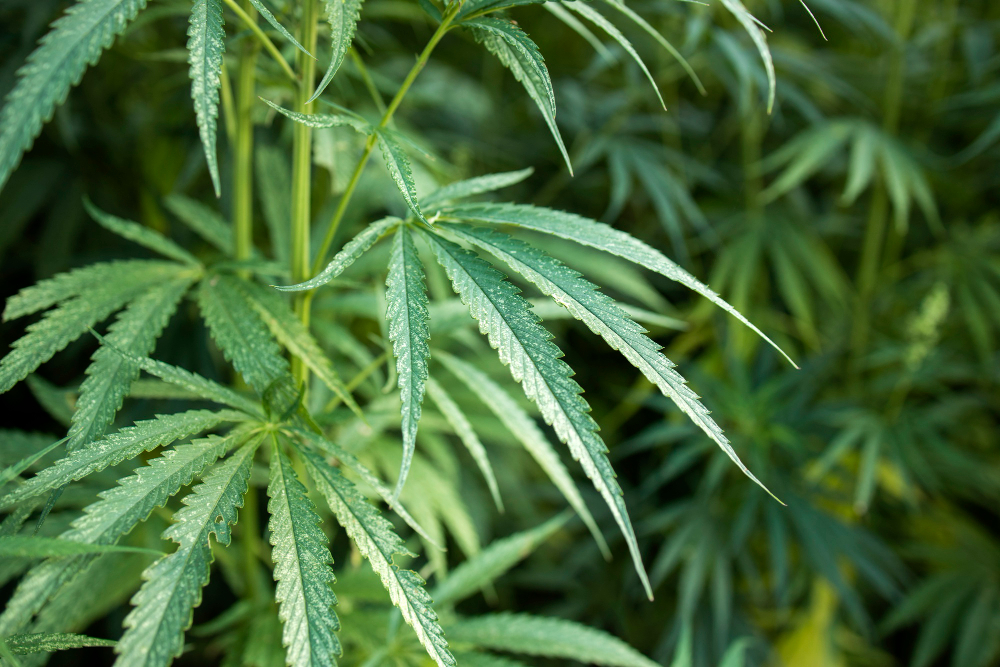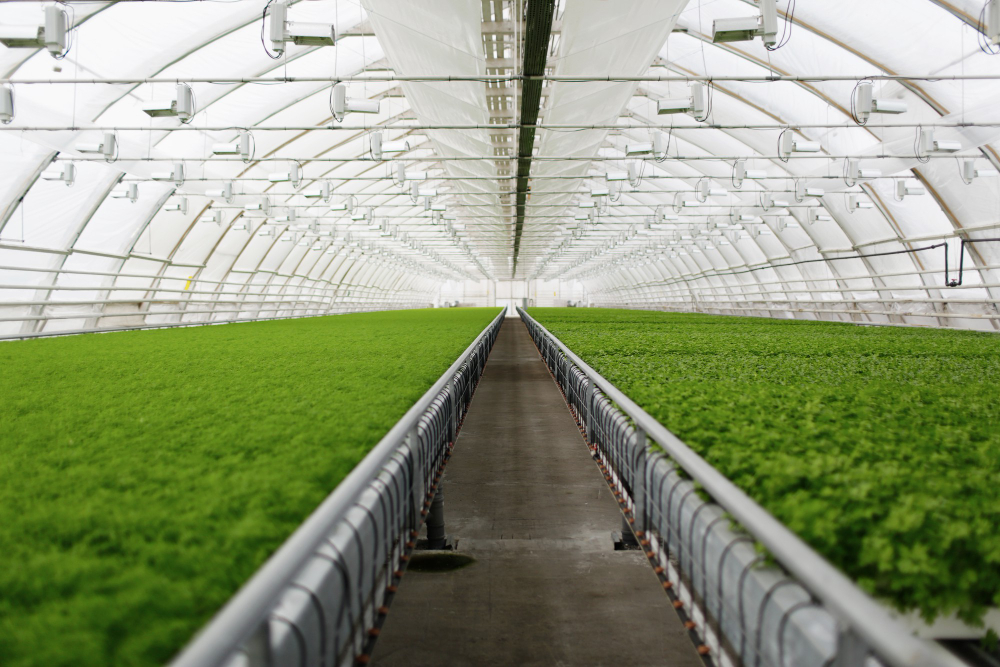Selecting the ideal cannabis greenhouse is crucial for maximizing yield and quality. At Agropharm, we specialize in providing cutting-edge greenhouse solutions tailored for medicinal cannabis cultivation. With the increasing global demand for THC and CBD medical cannabis, growers need precise control over environmental factors like light, humidity, and temperature.
Every company needs to consider an important question before deciding to build any type of facility to cultivate cannabis. How do I want to cultivate? It is key to choose the optimum facility type, which needs to be chosen according to each project needs. Usually the options are a technified greenhouses, hybrid greenhouse or indoor facilities.
A well-designed greenhouse for cannabis cultivation reduces operational costs compared to indoor production, meanwhile enhances plant characteristics compared to regular greenhouses. By choosing Agropharm’s innovative greenhouse solutions, cultivators can ensure consistency, efficiency, and top-tier product quality in this competitive industry.
The importance of a greenhouse in cannabis cultivation
Growing cannabis in a greenhouse offers the perfect balance between indoor and outdoor (no greenhouse) cultivation, making it the preferred choice for high-yield crops. Unlike indoor grows, which require an important CAPEX (capital expenditures) investment for costly artificial lighting and climate control systems, technified greenhouses and hybrid greenhouses utilize natural sunlight, which results in less supplementary lighting requirements, significantly reducing energy consumption while maintaining optimal growth conditions.
Another key advantage is protection from external threats. Outdoor crops are vulnerable to unpredictable weather, pests, and cross-pollination, all of which can compromise yield and quality. A cannabis greenhouse provides a controlled, semi-enclosed environment that shields plants from harsh climatic conditions and pathogens, ensuring consistent and robust growth.
For medicinal cannabis strains, precise control over humidity, temperature, and light cycles is essential. Greenhouses equipped with modern climate regulation systems allow growers to fine-tune these variables, maximizing cannabinoid and terpene production. This level of environmental control is crucial for producing high-quality CBD and THC products (and other cannabinoids) that meet industry standards.
Furthermore, regulatory compliance is a major concern in cannabis cultivation. Many legal markets mandate enclosed growing spaces to prevent unauthorized access and ensure proper monitoring. A greenhouse provides a secure, semi-controlled setting that meets these requirements while still benefiting from natural sunlight, making it a cost-effective and legally compliant solution.
At Agropharm we design cutting-edge greenhouses tailored for high-yield cannabis cultivation, helping growers optimize efficiency, ensure compliance, and produce superior-quality crops. Investing in the right greenhouse for cannabis is the key to sustainable, profitable, and high-performance cultivation.
Types of greenhouse for cannabis cultivation
Choosing the right cannabis greenhouse is essential for maximizing yield, energy efficiency, and plant quality. Different greenhouse structures offer unique advantages, making them suitable for various cultivation needs. Below is a detailed breakdown of the most common greenhouse types used in medicinal cannabis production. It is also important to consider that, no matter the type of greenhouse, supplementary light can be used to optimize plant growth and the number of cycles. Nevertheless, there are companies that produce GACP-certified cannabis with no supplementary lighting, obtaining a product that is not as optimized as it could, but still has an important demand in different markets.
Glass greenhouses
Glass greenhouses are considered the premium choice for cannabis cultivation due to their maximum light penetration, which optimizes photosynthesis and enhances plant growth. The transparency of glass allows natural sunlight to reach the crops, reducing the need for artificial lighting and improving energy efficiency.
Additionally, glass greenhouses are durable and aesthetically pleasing, often lasting for decades with minimal structural degradation. They provide excellent climate control when paired with advanced ventilation and heating systems.
However, the high initial investment can be a drawback for some growers. Installation and maintenance costs are typically higher than other greenhouse types, making glass structures ideal for long-term investment growers focused on premium cannabis production.
Another key factor is the location of the greenhouse, as glass greenhouses are designed to maximize natural sunlight, which might be very useful in certain climates with high latitudes (north european countries, canada, etc) but might be a problem in latitudes with extreme hot weather, such as the south of the Iberian Peninsula or some tropical countries (Thailand, Colombia, etc).
Polycarbonate greenhouses
Polycarbonate greenhouses are a cost-effective alternative to glass, offering strong insulation that helps regulate temperature and humidity. This enhanced insulation reduces heating and cooling costs, improving overall energy efficiency and making them well-suited for medicinal cannabis cultivation in regions with fluctuating temperatures.
Polycarbonate panels are also lightweight and impact-resistant, making them a durable option compared to fragile glass or polyethylene. The average lifespan of the polycarbonate panels is between 10 and 20 years, depending on quality, correct use and maintenance.
Despite their benefits, polycarbonate greenhouses may not provide the same level of light clarity as glass, which could require supplementary lighting in low-sunlight environments. Nevertheless, they offer an excellent balance of affordability, efficiency, and protection for mid-to-large-scale cannabis growers.
Plastic film (polyethylene) greenhouses
Plastic film greenhouses, often made from polyethylene, are the most budget-friendly option for commercial cannabis cultivation. Their low material cost and easy installation make them accessible for growers looking to scale production without heavy upfront investments.
These greenhouses provide good humidity control and can be adapted for seasonal grows, making them an attractive choice for cultivators operating in warmer climates.
However, polyethylene greenhouses require frequent maintenance and replacement every 3-4 years (depending on the location), as plastic films are prone to wear, tears, and degradation from sunlight exposure.
Hybrid greenhouses (semi-closed systems)
Hybrid greenhouses, also known as semi-closed systems, represent the future of high-yield cannabis cultivation in greenhouses. These structures combine the benefits of natural sunlight with advanced climate control technology, ensuring a consistent, optimized growing environment. They take advantage of certain characteristics from indoor cultivation, such as using sandwich panel walls; and other characteristics from technified greenhouses, such as HVAC systems using centralized equipment, or specific supplementary lighting according to the DLI (Daily Light Integral) objective chosen by the cultivation responsible of the project.
Equipped with automated ventilation, irrigation, and temperature regulation systems, hybrid greenhouses allow growers to precisely control humidity, CO₂ levels (although less than indoor facilities), and light exposure, maximizing plant growth and cannabinoid production. The integration of energy-efficient climate management reduces reliance on artificial heating and cooling, lowering operational costs over time.
Although hybrid greenhouses come with a higher investment cost, they ensure top-tier yield and efficiency, making them ideal for growers looking for maximum control and year-round cannabis production. Also, greenhouses usually allow for a higher range of response in case there is some issue with the cultivation cycle in comparison to indoor facilities.
Key factors to consider when choosing a cannabis greenhouse
Selecting the right cannabis greenhouse is crucial for achieving high-yield crops while ensuring cost efficiency, regulatory compliance, and optimal growing conditions. Below are the key factors every cannabis cultivator should consider when choosing the best greenhouse for medicinal cannabis cultivation.
Climate conditions
The regional climate plays a major role in determining the ideal greenhouse structure. Factors like temperature, humidity, and sunlight exposure impact the effectiveness of a greenhouse in maintaining stable conditions for cannabis growth.
For regions with hot climates, growers may need ventilation and cooling systems to prevent overheating, while colder areas require insulation and heating to maintain optimal temperatures. Some climates even require careful consideration of both strategies, as the thermal leap might be significant. Stability of the production is key in medicinal cannabis, which is only achieved by a thorough planification. Humidity control is also essential, as excessive moisture can lead to mold and fungal diseases, particularly for certain cannabis strains, which might require highly precise growing conditions. To maintain a stable microclimate, greenhouses should be equipped with climate control systems, such as automated ventilation, heating, and dehumidification, ensuring year-round production and protecting plants from extreme weather fluctuations.

Light management
Light exposure is one of the most critical factors for cannabis greenhouse cultivation, as it directly influences growth cycles, cannabinoid production, and overall yield. Maximizing natural sunlight helps reduce energy costs, but in regions with limited sun exposure, growers may need artificial supplemental lighting, such as LED luminaires specifically designed for lighting assimilation from plants, to ensure they receive adequate light intensity.
Blackout systems are also essential to control photo-period in greenhouse cultivation. These automated light deprivation systems help control the day-night cycle, ensuring plants transition smoothly between vegetative and flowering stages. By precisely managing light cycles, growers can enhance cannabinoid profiles and increase cannabinoid levels in their crops.
Energy efficiency & sustainability
As the cannabis industry grows, energy efficiency is becoming increasingly important. A well-designed greenhouse for cannabis cultivation should integrate sustainable practices to reduce operating costs while minimizing environmental impact.
Energy-efficient greenhouses use high-insulation materials to retain heat, reducing the need for artificial heating. Additionally, incorporating solar panels can offset energy consumption, while LED grow lights offer superior efficiency compared to traditional HPS or LEC lighting.
Advanced thermal insulation systems, such as double-layer polyethylene films and thermal screens, help maintain stable temperatures and reduce energy waste. By prioritizing sustainability, growers can lower long-term costs while producing high-quality, eco-friendly cannabis.
Legal & regulatory considerations
Cannabis cultivation is highly regulated, and compliance with legal frameworks is essential when selecting a cannabis greenhouse. Many countries and states require enclosed growing environments to prevent unauthorized access and ensure traceability.
Greenhouses must adhere to security regulations, including restricted entry, surveillance systems, and fencing, to prevent theft or unauthorized cultivation. Additionally, compliance with environmental laws—such as waste management and water usage restrictions—can impact the choice of greenhouse design.
For medical cannabis cultivation, traceability is key. Many legal markets require growers to document and monitor environmental conditions, phytosanitary products use, and production processes. Implementing automated monitoring systems and traceability software helps ensure compliance with safety and quality control standards.
How Agropharm helps you build the perfect greenhouse
At Agropharm, we specialize in designing and building indoor facilities and any type of greenhouses for medicinal cannabis, maximizing high-yield crops while optimizing energy efficiency. With our expertise and lessons learned after four licensed cannabis facilities built in Iberian Peninsula (greenhouse and indoor), we provide customized solutions tailored to your specific climate, strain requirements, and production goals, managing a precise and accurate dimensioning of the project during the planning phase.
Our high-efficiency greenhouse designs incorporate advanced climate control systems, ensuring stable humidity, temperature, and light cycles to enhance cannabinoid production. Whether you need polyethylene, polycarbonate, glass, or hybrid greenhouses, our structures are engineered to reduce energy costs and improve sustainability, depending on the unique characteristics of the project.
Beyond construction, Agropharm offers ongoing technical support and consulting to help cultivators maximize yield and efficiency. From selecting the right materials to integrating automated systems for irrigation, climate and light management, we guide you every step of the way.
Partner with Agropharm and build the perfect greenhouse for cannabis cultivation, ensuring long-term success in the rapidly growing cannabis industry. Need more information about what we offer at Agropharm? Then contact us and we will help you with the best advice.
